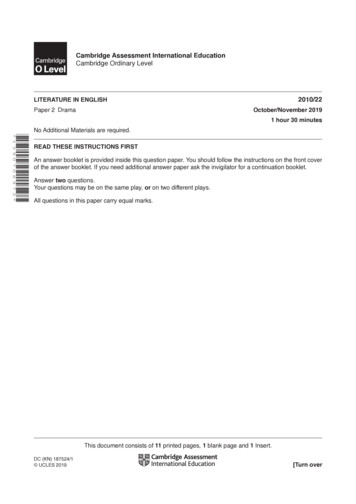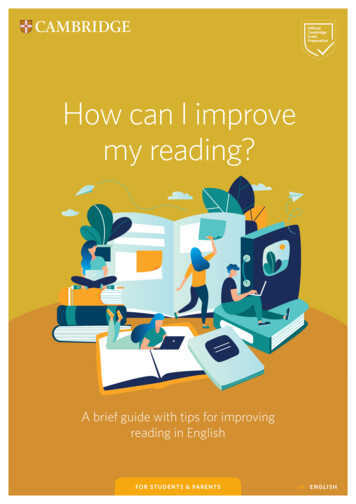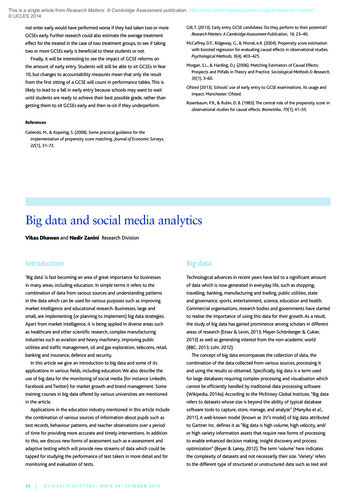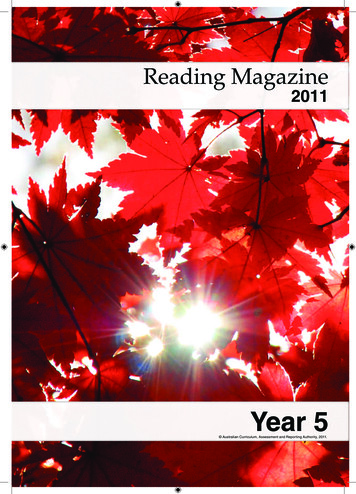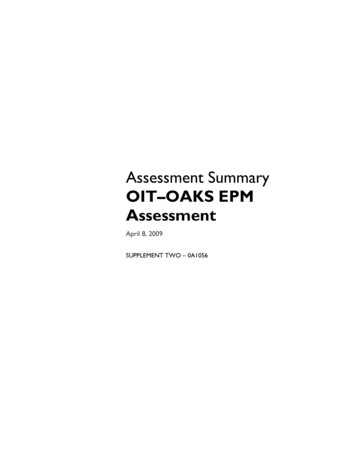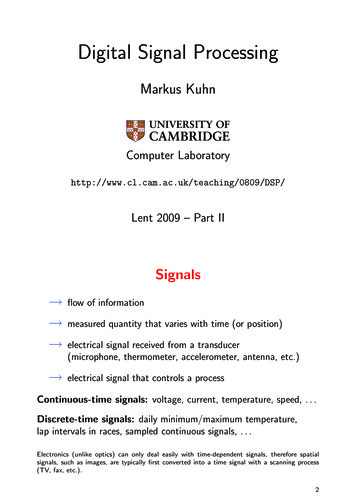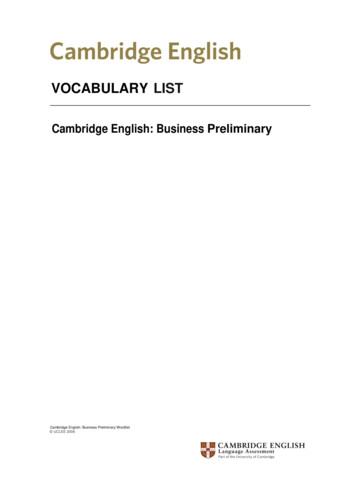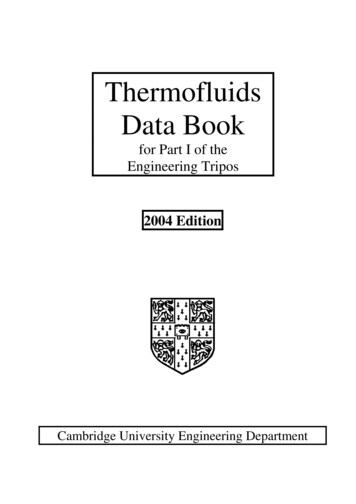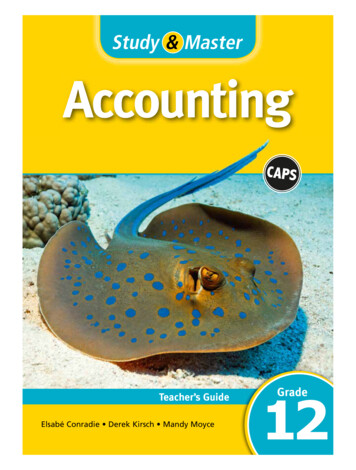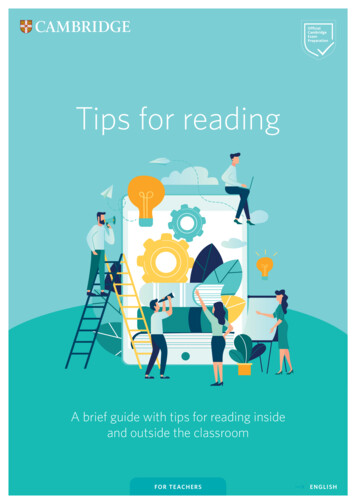
Transcription
Tips for readingA brief guide with tips for reading insideand outside the classroomFOR TEACHERSENGLISH
Contents1Introduction2Reading in general- advice for students3Reading in exams- advice for students4A reading tipfor the updated2020 exams
1 IntroductionThis guide is aimed at teachers preparingstudents for a Cambridge EnglishQualification such as A2 Key or A2 Keyfor Schools, B1 Preliminary or B1 Preliminaryfor Schools.The guide contains some simple,practical steps for students to helpthem improve their reading in Englishand develop their reading skills andstrategies in a reading test.The guide also includes one lessonactivity idea for Reading Part 1 fromthe January 2020 revised A2 Keyand A2 Key for Schools.K E Y AN D P R EL IM IN A R Y . C A MBRI DGE E N GLI S H. ORGT I P S FOR IMPROVING LISTENING IN ENG LISH
2 Reading in generaladvice for studentsARead as much as possible.Try to read in English as often aspossible. A little bit every day ortwo helps a lot. Go back and re-readtexts a second time and a third time.This helps to familiarise you with theuse of English in real sentences andexpressions.BRead for fun.Reading is at its most enjoyable whenthe flow is uninterrupted, when youget absorbed in a good story or aninteresting article, when time fliesby. It’s no different when you readin a another language. If a text is toodifficult, if there are too many wordsor phrases you don’t understand, thenreading becomes difficult, it stops beingfun. Where possible, don’t just read forstudy and work purposes, read thingsthat interest you too.KE Y AN D P R EL IM IN A R Y . C A MBRI DGE E N GLI S H. ORGT I P S FOR IMPROVING LISTENING IN ENG LISH
CKeep on reading.It’s natural to stop in a text at a word orexpression we don't understand and freeze.Unfamiliar words can disrupt the flow ofreading and understanding. Don't stop!When you arrive at an unfamiliar word thenskip it and keep reading. When you get tothe end of the passage, read it a secondtime using the same technique. The contextwith the words you do understand shouldhelp you to unlock the general meaning ofthe whole text. You can revisit words youdon’t know later and look them upin a dictionary or ask someone.DReading improves everything.Lots of research has been carried outon reading in a foreign language andit clearly shows that reading practicedoesn’t just improve reading. It alsohelps you to get better at English inwriting, speaking and listening as youbecome more familiar with words andhow words are used in context.K E Y AN D P R EL IM IN A R Y . C A MBRI DGE E N GLI S H. ORGT I P S FOR IMPROVING LISTENING IN ENG LISH
3 Reading in examsadvice for studentsABe prepared.Know exactly what each type of questionis asking you to do. Is it a multiplechoice? Is it filling in the gaps of a text?How many words do you have to write?How much time do you have? It's a goodidea to underline important words in anyexam question to help you focus on theinstructions.BSpeed up.In exam situations you will often needto read a text more quickly than before.Practise reading texts quickly: you cantime yourself. For example, give yourself3 minutes to read 300 words, then giveyourself 2 minutes to read 300 words,then try in 1 minute. You can repeatthis idea with the same text at first, butthen try it with different texts as you getbetter at it.K E Y AN D P R EL IM IN A R Y . C A MBRI DGE E N GLI S H. ORGT I P S FOR IMPROVING LISTENING IN ENG LISH
CDon’t freeze.Remember, in an exam you aren’t allowedto ask someone or look up a new word.If you don’t know a word, and you can’t guessa general meaning from the other wordsaround it, then skip it, don’t waste time!DMake predictions.When a question gives you multipleanswers to choose from, try to answerthe question without looking at theanswers first. Then look at the answersand check if one matches your prediction.EPractise.There are lots of materials available tohelp you prepare for Cambridge EnglishQualifications such as A2 Key or B1Preliminary. Get as much practice as you canwith different question types from the readingpaper. You can find information on our booksfrom Cambridge University Pressin www.cambridge.org and links to extraresources, sample tests, and more fromCambridge Assessment English inwww.cambridgeenglish.orgK E Y AN D P R EL IM IN A R Y . C A MBRI DGE E N GLI S H. ORGT I P S FOR IMPROVING LISTENING IN ENG LISH
4 A reading tip for theupdated 2020 examsNew exam formats will start being usedfrom January 2020 for A2 Key and A2 Keyfor Schools and B1 Preliminary andB1 Preliminary for Schools.The Reading and Writing paper in A2 Keyand A2 Key for Schools will be shortenedfrom 9 parts to 7 parts.READING PART 1AB What is it?Six short texts with multiple choicesentences.What do you have to do?Read each text and choose the correctsentence: A, B or C.This tip is for the updated Reading andWriting Part 1. The activity in this tip alsoworks with B1 Preliminary and B1 Preliminaryfor Schools Reading Part 1.K E Y AN D P R EL IM IN A R Y . C A MBRI DGE E N GLI S H. ORGT I P S FOR IMPROVING LISTENING IN ENG LISH
Tip: Thinking about the mainpurpose of a short textCopy and cut up six short texts and questions takenfrom any A2 Key or Key for Schools Reading Part 1.Prepare one set for each group of 5 or 6 students.P R E P A R ATIONStep1TIMEAbout 15 minsAGEGive each group the six cut up texts(not the questions)Where canyou see textslike this?What kindof text is it?Share ideasK E Y AN D P R EL IM IN A R Y . C A MBRI DGE E N GLI S H. ORGT I P S FOR IMPROVING LISTENING IN ENG LISHAny
Step2Next, give each groupthe six questionsMatch thequestions to thecorrect textWhich wordshelped you?Check togetherB I G CL ASSESPut each text on the wall and ask studentsto move around the class in pairs or smallgroups. Then, give all the 6 questions to eachgroup on a handout and ask them to matcheach question to a different text on the wall.K E Y AN D P R EL IM IN A R Y . C A MBRI DGE E N GLI S H. ORGT I P S FOR IMPROVING LISTENING IN ENG LISH
Step3Finally students read and answereach questionCheckanswersExtra educational benefitsCOLLABORATIONCOMMUNICATIONCRITICAL THINKINGEach group workstowards a commonobjective.Students are requiredto speak and listen inaddition to the readingrequired by the text.Students considerdifferent options andhave to look for linksbetween ideas.Source: The Cambridge Life Competencies Framework.K E Y AN D P R EL IM IN A R Y . C A MBRI DGE E N GLI S H. ORGT I P S FOR IMPROVING LISTENING IN ENG LISH
For more tips and lessons on reading for exams visitpracticemakesperfect.cambridge.orgExperts togetherYour classroom is where the learning takes place. You are thefacilitator, the language guide, the coach. You understand yourlearners and their needs. You are the experts. We listen to you,building our materials from what you tell us you need.Experts togetherOur aim is to deliver the materials you tell us you need.Exclusive insights from test development and candidateperformance guarantee expert content. The result is a uniqueExam Journey in each course, ensuring every student is readyon exam day. From skills development to exam tasks, languagediscovery to real-world usage, we create better learningexperiences, together.
and develop their reading skills and strategies in a reading test. The guide also includes one lesson activity idea for Reading Part 1 from . the January 2020 revised A2 Key . KEYANDPRELIMINARY.CAMBRIDGEENGLISH.OR G TIPS FOR IMPROVING LISTENING IN ENGLISH. C D. Keep on readin
